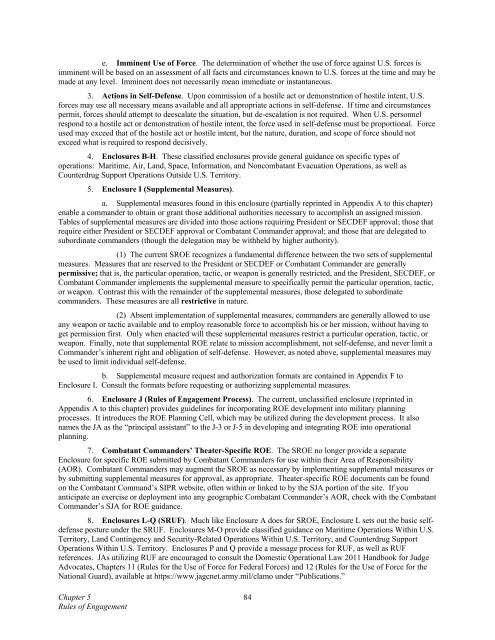The Law of War
The Law of War
The Law of War
You also want an ePaper? Increase the reach of your titles
YUMPU automatically turns print PDFs into web optimized ePapers that Google loves.
e. Imminent Use <strong>of</strong> Force. <strong>The</strong> determination <strong>of</strong> whether the use <strong>of</strong> force against U.S. forces is<br />
imminent will be based on an assessment <strong>of</strong> all facts and circumstances known to U.S. forces at the time and may be<br />
made at any level. Imminent does not necessarily mean immediate or instantaneous.<br />
3. Actions in Self-Defense. Upon commission <strong>of</strong> a hostile act or demonstration <strong>of</strong> hostile intent, U.S.<br />
forces may use all necessary means available and all appropriate actions in self-defense. If time and circumstances<br />
permit, forces should attempt to deescalate the situation, but de-escalation is not required. When U.S. personnel<br />
respond to a hostile act or demonstration <strong>of</strong> hostile intent, the force used in self-defense must be proportional. Force<br />
used may exceed that <strong>of</strong> the hostile act or hostile intent, but the nature, duration, and scope <strong>of</strong> force should not<br />
exceed what is required to respond decisively.<br />
4. Enclosures B-H. <strong>The</strong>se classified enclosures provide general guidance on specific types <strong>of</strong><br />
operations: Maritime, Air, Land, Space, Information, and Noncombatant Evacuation Operations, as well as<br />
Counterdrug Support Operations Outside U.S. Territory.<br />
5. Enclosure I (Supplemental Measures).<br />
a. Supplemental measures found in this enclosure (partially reprinted in Appendix A to this chapter)<br />
enable a commander to obtain or grant those additional authorities necessary to accomplish an assigned mission.<br />
Tables <strong>of</strong> supplemental measures are divided into those actions requiring President or SECDEF approval; those that<br />
require either President or SECDEF approval or Combatant Commander approval; and those that are delegated to<br />
subordinate commanders (though the delegation may be withheld by higher authority).<br />
(1) <strong>The</strong> current SROE recognizes a fundamental difference between the two sets <strong>of</strong> supplemental<br />
measures. Measures that are reserved to the President or SECDEF or Combatant Commander are generally<br />
permissive; that is, the particular operation, tactic, or weapon is generally restricted, and the President, SECDEF, or<br />
Combatant Commander implements the supplemental measure to specifically permit the particular operation, tactic,<br />
or weapon. Contrast this with the remainder <strong>of</strong> the supplemental measures, those delegated to subordinate<br />
commanders. <strong>The</strong>se measures are all restrictive in nature.<br />
(2) Absent implementation <strong>of</strong> supplemental measures, commanders are generally allowed to use<br />
any weapon or tactic available and to employ reasonable force to accomplish his or her mission, without having to<br />
get permission first. Only when enacted will these supplemental measures restrict a particular operation, tactic, or<br />
weapon. Finally, note that supplemental ROE relate to mission accomplishment, not self-defense, and never limit a<br />
Commander’s inherent right and obligation <strong>of</strong> self-defense. However, as noted above, supplemental measures may<br />
be used to limit individual self-defense.<br />
b. Supplemental measure request and authorization formats are contained in Appendix F to<br />
Enclosure I. Consult the formats before requesting or authorizing supplemental measures.<br />
6. Enclosure J (Rules <strong>of</strong> Engagement Process). <strong>The</strong> current, unclassified enclosure (reprinted in<br />
Appendix A to this chapter) provides guidelines for incorporating ROE development into military planning<br />
processes. It introduces the ROE Planning Cell, which may be utilized during the development process. It also<br />
names the JA as the “principal assistant” to the J-3 or J-5 in developing and integrating ROE into operational<br />
planning.<br />
7. Combatant Commanders’ <strong>The</strong>ater-Specific ROE. <strong>The</strong> SROE no longer provide a separate<br />
Enclosure for specific ROE submitted by Combatant Commanders for use within their Area <strong>of</strong> Responsibility<br />
(AOR). Combatant Commanders may augment the SROE as necessary by implementing supplemental measures or<br />
by submitting supplemental measures for approval, as appropriate. <strong>The</strong>ater-specific ROE documents can be found<br />
on the Combatant Command’s SIPR website, <strong>of</strong>ten within or linked to by the SJA portion <strong>of</strong> the site. If you<br />
anticipate an exercise or deployment into any geographic Combatant Commander’s AOR, check with the Combatant<br />
Commander’s SJA for ROE guidance.<br />
8. Enclosures L-Q (SRUF). Much like Enclosure A does for SROE, Enclosure L sets out the basic selfdefense<br />
posture under the SRUF. Enclosures M-O provide classified guidance on Maritime Operations Within U.S.<br />
Territory, Land Contingency and Security-Related Operations Within U.S. Territory, and Counterdrug Support<br />
Operations Within U.S. Territory. Enclosures P and Q provide a message process for RUF, as well as RUF<br />
references. JAs utilizing RUF are encouraged to consult the Domestic Operational <strong>Law</strong> 2011 Handbook for Judge<br />
Advocates, Chapters 11 (Rules for the Use <strong>of</strong> Force for Federal Forces) and 12 (Rules for the Use <strong>of</strong> Force for the<br />
National Guard), available at https://www.jagcnet.army.mil/clamo under “Publications.”<br />
Chapter 5 84<br />
Rules <strong>of</strong> Engagement

















